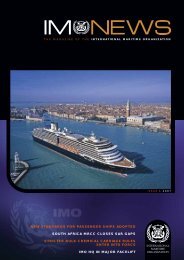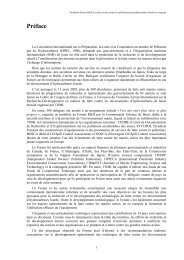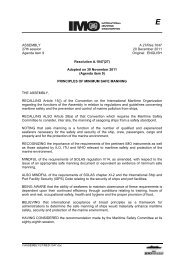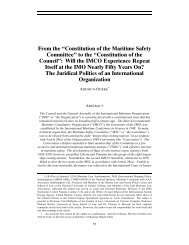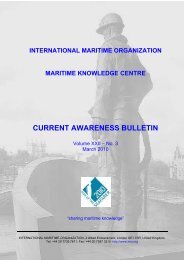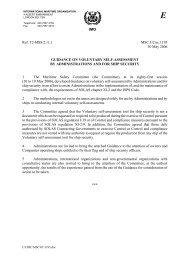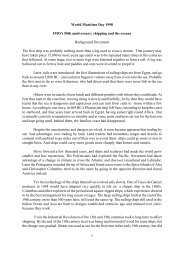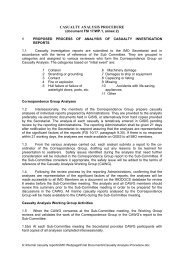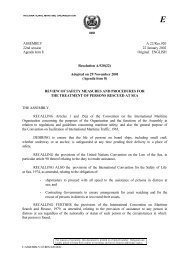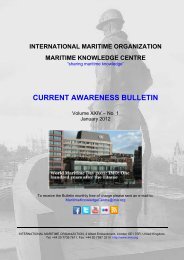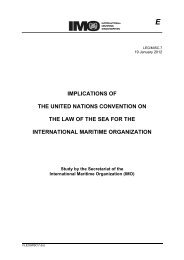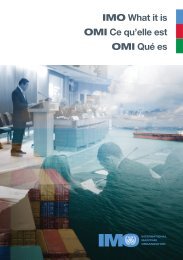Radioactive Waste Disposal at Sea: Public Ideas ... - IMO
Radioactive Waste Disposal at Sea: Public Ideas ... - IMO
Radioactive Waste Disposal at Sea: Public Ideas ... - IMO
You also want an ePaper? Increase the reach of your titles
YUMPU automatically turns print PDFs into web optimized ePapers that Google loves.
Knowledge-Based Regime Analysis 65<br />
Arctic and tropical w<strong>at</strong>ers, let alone the consequences of effluent disposal<br />
and accidental pollution in them.” (Harwood 1971) Two years l<strong>at</strong>er, it was<br />
obvious th<strong>at</strong> there still was a gre<strong>at</strong> gap in scientific knowledge about pollution<br />
of the seas. “Despite broad general consensus about the contaminants<br />
which represent the gre<strong>at</strong>est thre<strong>at</strong> of global pollution,” said the head<br />
of the U.S. N<strong>at</strong>ional Oceanic and Atmospheric Administr<strong>at</strong>ion in 1973,<br />
“knowledge of their full extent, their f<strong>at</strong>e and their impact on the ocean<br />
ecosystem is scanty <strong>at</strong> best” (Newman 1973). 18 This lack of knowledge did<br />
not, however, dampen regul<strong>at</strong>ory policy making.<br />
The question of whether available knowledge of w<strong>at</strong>er and marine pollution<br />
could guide, and should guide, policy making had already been raised<br />
before the CEQ issued its report on ocean dumping. The scientific basis of<br />
a proposal to control w<strong>at</strong>erways, included in the 37-point program presented<br />
<strong>at</strong> the first “Message on the Environment” in February of 1970, had<br />
been received with skepticism. Under this plan, rivers and lakes were<br />
assumed to have a capacity to absorb waste without becoming polluted<br />
(technically known, as already mentioned, as the assimil<strong>at</strong>ive capacity), and<br />
through fair alloc<strong>at</strong>ion of this capacity among all industrial and municipal<br />
sources precise limits on the amount of waste dumped into a river or lake<br />
would be assigned. 19 But the Nixon administr<strong>at</strong>ion’s proposal, which<br />
allowed waste discharges but would avoid pollution, did not have the full<br />
consent of the Congress. Influential legisl<strong>at</strong>ors disagreed with, in Represent<strong>at</strong>ive<br />
John Dingell’s words, “some of the industrial and municipal folks who<br />
have ideas we should utilize the streams and lakes and oceans up to their<br />
assimil<strong>at</strong>ive capacity.” 20 The newly cre<strong>at</strong>ed EPA did not intend to base its<br />
policy on the assimil<strong>at</strong>ive capacity concept and seemed generally very reluctant<br />
about market-based and other approaches th<strong>at</strong> might have been interpreted<br />
as favoring selling “licenses to pollute” (Wilson 1980, p. 376). 21<br />
Concerns were also expressed about the st<strong>at</strong>e of the art in this field. “We<br />
just don’t know enough about a river’s assimil<strong>at</strong>ive capacity,” objected one<br />
Sen<strong>at</strong>e w<strong>at</strong>er expert. “The best route is no dumping <strong>at</strong> all, but th<strong>at</strong>’s not wh<strong>at</strong><br />
Nixon seemed to say.” (“Pollution: The B<strong>at</strong>tle Plan,” Newsweek, February<br />
23, 1970)<br />
The CEQ report on ocean dumping actually acknowledged th<strong>at</strong> existing<br />
knowledge of ocean pollution was either rudimentary or, in fact, did not<br />
exist. 22 It had, in addition, been impossible to separ<strong>at</strong>e the effects of ocean<br />
dumping from the broader issue of ocean pollution. The Council on



